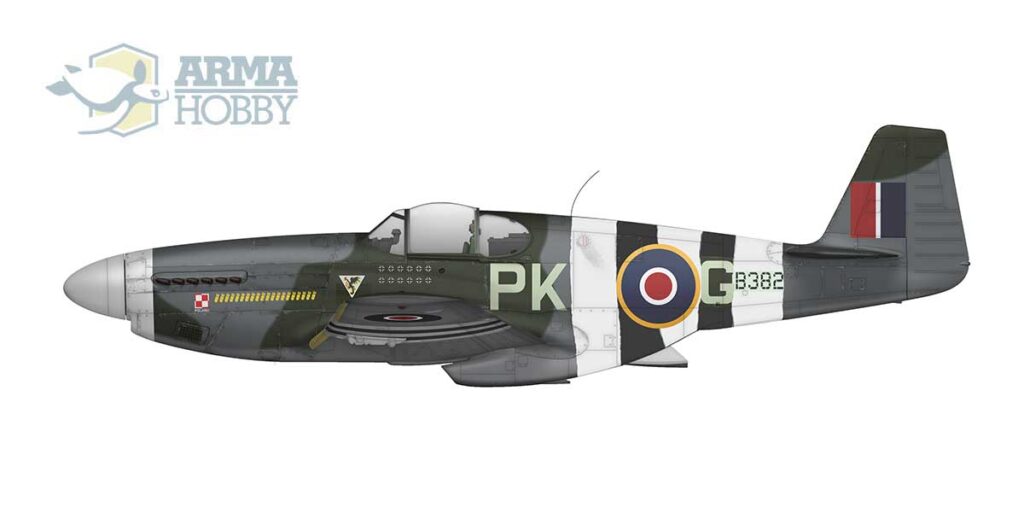
Specially for the launch of our new P-51C Mustang Mk III model kit, Wojtek Matusiak wrote a detailed history of one of the most famous Polish airplanes – Mustang FB 382 with PK-G marking. In July 1944 this aircraft was the personal plane of 315 Squadron’s commander, the legendary Eugeniusz “Dziubek” Horbaczewski. Flying this plane the pilot scored 1 ½ ‘kill’ against German aircraft, and a few ‘kills’ against V1 flying bombs (3 individual and 2 shared).
No. 315 Squadron on Mustangs
During WWII North American Mustangs were used by five squadrons of the exiled Polish Air Force. Notably, according to the Anglo-Polish agreements, the Polish Armed Forces (including the air force) were an independent force of an allied country. Thus, the exiled Polish Air Force in Britain was not part of the Royal Air Force (as it is often erroneously seen by today’s authors), even though in terms of operational and logistics structures it was integrated with allied forces, the RAF first of all.

S/Ldr Eugeniusz Horbaczewski by the side of his final personal PK-G-coded Mustang III, serial no. FB387. The mission markings: yellow bomb symbols to denote ground attack sorties, and the score of German aircraft destroyed (black crosses) and of downed V1s (swastikas with V1 silhouettes superimposed) all refer to the operational flying he had done on his previous aeroplanes.
The fighter force of the Polish Air Force followed the Royal Air Force in both its organisation and equipment. By 1943 its fighter squadrons were combined in three wings. By the beginning of 1944 two of these were allocated to the 2nd TAF as first line formations: the 1st Wing was labelled No. 131 (Polish) Wing in the TAF structure and the 2nd Wing became No. 133 (Polish) Wing. Until spring 1945 the 3rd Wing of the Polish Air Force was considered a reserve pool, its two squadrons providing personnel replacements for the other two wings.
In the spring of 1944 it was decided to re-equip No. 133 Wing (the 2nd Polish Wing) with Mustang IIIs. The wing included at the time only two squadrons: Nos. 306 and 315. As there was no spare Polish day fighter unit to bring No. 133 Wing to its establishment strength of three squadrons, an RAF unit (No. 129 ‘Mysore’ Sqn) was added to it. The entire wing assembled at Heston in late March 1944 and moved to Coolham ALG (Advanced Landing Ground) on 1 April. It converted onto Mustang IIIs during April, commencing operations on the type by the end of the month, while preparing for the landings in France
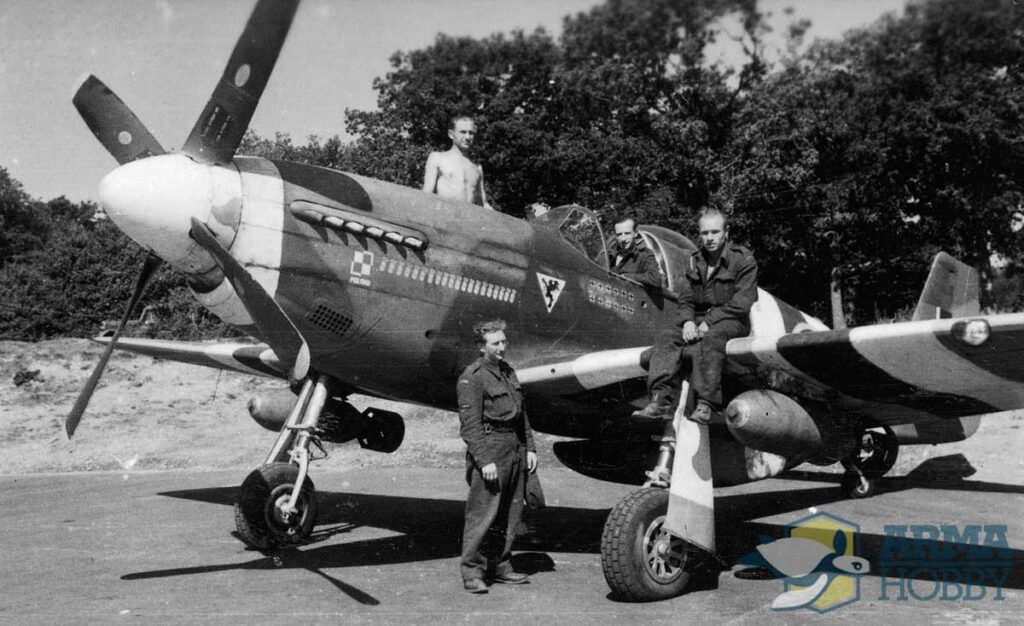
The last but one personal mount of S/Ldr Eugeniusz Horbaczewski, with his personal log of air-to-air victories and ground attack missions applied on the fuselage side, photographed at RAF Ford on 24 June 1944. This Mustang III, which is sometimes misidentified as ‘FB166’, was in fact FB382. The photo is sometimes captioned as showing Horbaczewski himself in the cockpit, but in reality all the men here (including the one in the pilot’s seat) are ground crew members.
Originally it was planned that No. 133 would move to the continent when beachhead airfields became available. To get some practice in the mobile airfield concept, No. 133 Wing moved to Holmsley South on 22 June and then to Ford a few days later.
However, within a week from D-Day the Germans started to launch their V1 ‘divers’ against London. Soon it was decided to assign Polish Mustang units to anti-diver duties. For that reason, No. 133 Wing moved to Brenzett on 10 July.
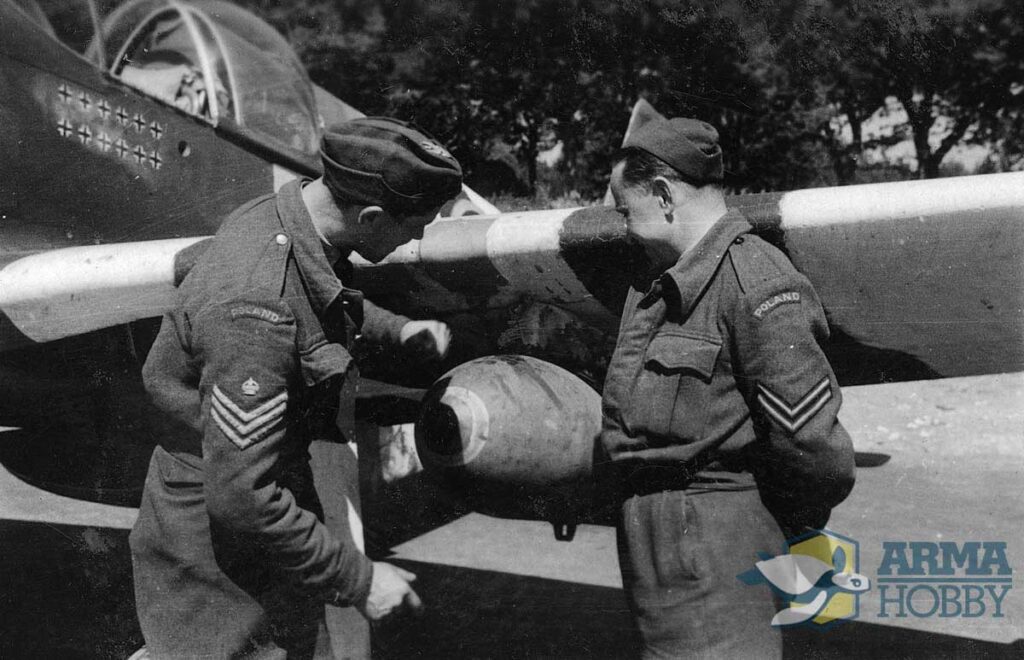
Two ground crew NCOs check the attachment of the under-wing bomb. Note the 12 black crosses near the cockpit.
Eugeniusz Horbaczewski
Born in Kiev, then in Russia, on 28 September 1917, to a Polish family of Witold and Anna nee Kozłowska. In 1935 he completed a glider pilot’s training at Ustianowa as part of his initial military training. He completed his secondary education in Brześć (now Brest-Litovsk in Belarus) in 1936. In 1937 he completed aeroplane pilot’s training at Bielsko-Aleksandrowice, also within the initial military training programme. He joined the Polish Air Force Cadet Officers’ School at Dęblin in January 1938 and was commissioned on 1 September 1939 as a fighter pilot.
He was one of the cadet pilots charged with evacuating PZL P.7a fighters by air. During 9–11 September he flew several patrols. Following the Soviet invasion on 17 September he flew his aircraft to Romania. Via Yugoslavia and Greece he went to France, where he was then posted for training at Bordeaux-Merignac.
Details of the markings on the port side of FB382 in frames of a film shot at Coolham on 18 June 1944. Photos 06 and 07 show squadron badge applied on top of the original USAAF data box that was masked off during application of RAF camouflage. The badge of No. 315 Squadron was derived from that of the pre-war 112 Eskadra of the Polish Air Force, it faced forward on both sides.
He arrived in Britain on 21 June 1940 (receiving service no. P-0273). He underwent flying training, followed by a practice at No. 2 Anti-Aircraft Co-operation Unit (March-May 1941), and then at No. 2 Bombing & Gunnery School, subsequently reformed into No. 2 Air Observers School (May-July 1941). On 15 July 1941 he was sent to No. 18 Operational Training Unit for bomber pilot training, but a few days later transferred to No. 58 OTU.
He was posted to No. 303 Sqn at the end of August 1941. On 10 September 1942 he was posted to No. 302 Squadron. On 3 December he was posted to No. 58 OTU as an instructor.
He volunteered to join the Polish Combat Team (later known informally as the ‘Skalski’s Circus’), with which he fought in North Africa from mid-March 1943. He then volunteered to stay in the Mediterranean, initially flying missions with No. 601 Sqn RAF. On 6 July 1943 he was posted to No. 43 Sqn RAF for flight commander duties. On 9 August 1943 he was appointed commander of the squadron as the third (and last) Polish officer to hold such post with an RAF unit.
„Zgłaszam jeden ME 262 zestrzelony” – historia Jerzego Mencla i jego Mustanga III
He returned to Britain in late October 1943, scheduled to take command of No. 303 Sqn, but failed to do so due to an illness. On 15 February 1944 he took command of No. 315 Sqn. On 18 August 1944 he led his squadron flying North American Mustang III FB355 PK-K for Rodeo 385. About 8.00 a.m. at Beauvais (France) they encountered a large formation of Focke Wulf Fw 190s. S/Ldr Horbaczewski took part in his unit’s victorious combat but for unknown reasons his aircraft then crashed at Velennes (Oise), killing the pilot.
His body was exhumed from the crash site on 3 March 1947 and he was buried at the communal cemetery in Creil, Oise (France), grave no. Z 379, military plot.
His decorations included the Golden Cross of Virtuti Militari Order (posthumously), the Silver Cross of Virtuti Militari Order, the Cross of Valour & three bars, the Distinguished Service Order and the Distinguished Flying Cross.
A sequence of photos from Coolham on 18 June 1944. FB382, bombed-up, ready for a mission. Note that the yellow leading edge stripe extends down to the wing root.
Mustang FB382 PK-G
It was built at the North American plant at Dallas, Texas, as a P-51C, USAAF serial no. 42-103532.
It is not clear which colour scheme was applied at the factory. It may have been the USAAF standard scheme of the time: Olive Drab on top and Neutral Gray underneath, or the RAF Temperate Land scheme, consisting of areas of dark greyish brown and dark greyish green on top with pale greenish grey undersides (with US standard paints that were no direct equivalents of the RAF hues), in the basic (A) pattern. Upon delivery to the RAF it was repainted with British paints into the Day Fighter Scheme of Dark Green and Ocean Grey on top, with Medium Sea Grey bottom surfaces. The factory applied data panel was masked off, leaving a paler rectangle of Olive Drab.
The serial number position on top of the Sky band was unusual on repainted Mustangs, which usually featured this number aft of the band. During the (very crude) application of D-Day bands the serial was masked off, which left a section of the Sky band still visible.
A sequence of stills from a film shot by the PAF Film Unit, probably on the same occasion. S/Ldr Horbaczewski in FB382 taxies out for take-off.
Following delivery to Britain FB382 was allocated to No. 315 Squadron at Coolham in mid-June 1944. S/Ldr Horbaczewski chose it as his new personal aircraft, his earlier PK-G, FB166, having been damaged in combat on 12 June.
During July 1944 ‘Horby’ scored a number of ‘kills’ in the Mustang, both against V1s (code-named ‘diver’) and manned Luftwaffe aircraft. His personal combat reports from these engagements are transcribed below.
‘S/Ldr Horbaczewski of 315 Squadron, flying a Mustang III took off at 1116 and landed Brenzett at 1158, under control of “GINFIZZ”. 1/2 a diver destroyed. Intercepted over BRENZETT, 3000 feet, 300 degrees, 400 I.A.S. Line astern attack from 400 yards. Starboard wing went down, and then Tempest arrived, opening fire. Diver crashed and exploded on ground 3 miles N.W. Appledore. Time of combat 1148.
‘S/Ldr Horbaczewski & F/Sgt Jankowski of 315 Squadron, flying Mustang III took off at 1240 and landed Brenzett at 1427, under control of “GINFIZZ”. Diver intercepted HASTINGS, 3000 feet, 330 degrees, 370 I.A.S. Attacked from dead astern, firing 3 long bursts from 300, closing to 50 yards. Strikes seen on both wings, and on impulse engine. Diver slowed down to about 200 MPH. and slipping, turned to port and crashed at approx. R.1643 at 1400 hours. F/Sgt Jankowski attacked from line astern, firing a long burst from 300/200 yards.’
20 July
‘S/Ldr Horbaczewski of 315 Squadron, flying a Mustang III took off at 0950 hours, and landed at 1135 at Brenzett, under control of “GINFIZZ”. A diver was intercepted 3 miles south of HYTHE, 1500 feet, 310 degrees. When flying 8000 feet over gun belt, no gun fire seen. Pilot dived vertically and when pulling out looped in front of and close to diver, which then turned over and crashed into sea 1 mile south of HYTHE approx. at 1055 hours.’
29 July
‘S/Ldr Horbaczewski of 315 Squadron, flying a Mustang III on aircraft test, took off at 2052, and landed Brenzett at 2200. 2 divers destroyed. First intercepted DUNGENESS at 3000 feet, 330 degrees, 360 I.A.S. Attacked from port quarter, firing 1 burst from 200 yards. The impulse engine caught fire and diver lost speed exploding on ground at approx R.4148 at 2130. When diver dived to ground, some other aircraft seen firing. Second intercepted 4 miles N.W. HASTINGS, 3000 feet, 340 degrees, 360 I.A.S. Attacked from line astern firing several bursts from 200, closing to 100 yards. The impulse engine seen to catch fire, diver lost speed and exploded on ground at approx R.1653. When diver was about to crash a Spitfire with letters 3WN seen firing.’
30 July
‘S/Ldr HORBACZEWSKI. I was leading the Squadron escorting Beaufighter over Norwegian coast. At 1555 approx we met about 15 Me.109F, and attacked them. We were above them and Me’s were apparently not expecting to see S/E [single-engined] Fighters so far North, as they took no evasive action, possibly mistaking us for other Me 109s. I dived down on them and gave one a three second burst after which he caught fire and went straight into the sea. I climbed up and when climbing I spotted another Me 109 below me. I came down and gave him a long burst. Strikes were seen in the cockpit and on the wings, glycol began to leak from E/a [Enemy aircraft] and it was losing speed and height. My guns jammed so I formated on him and started calling by R/T my number 2. The E/A had no hood and I could see that the pilot’s face was covered in blood and he put up his hands. He was heading towards the Norwegian coast so I ordered my number 2 to open fire. After two bursts my number 2 overshot him and E/A went into the sea. When last seen pilot was adjusting his Mae West. I claim 1 1/2 Me 109F destroyed.’
Photo above-right: A camera-gun sequence from S/Ldr Horbaczewski’s FB382 PK-G, showing his successful attack on a Messerschmitt 109 off Norwegian coast.
Presumably disappointed by the guns jamming in the crucial moments, ‘Horby’ had the aircraft replaced. A few days later his personal code PK-G was applied on Mustang FB387.
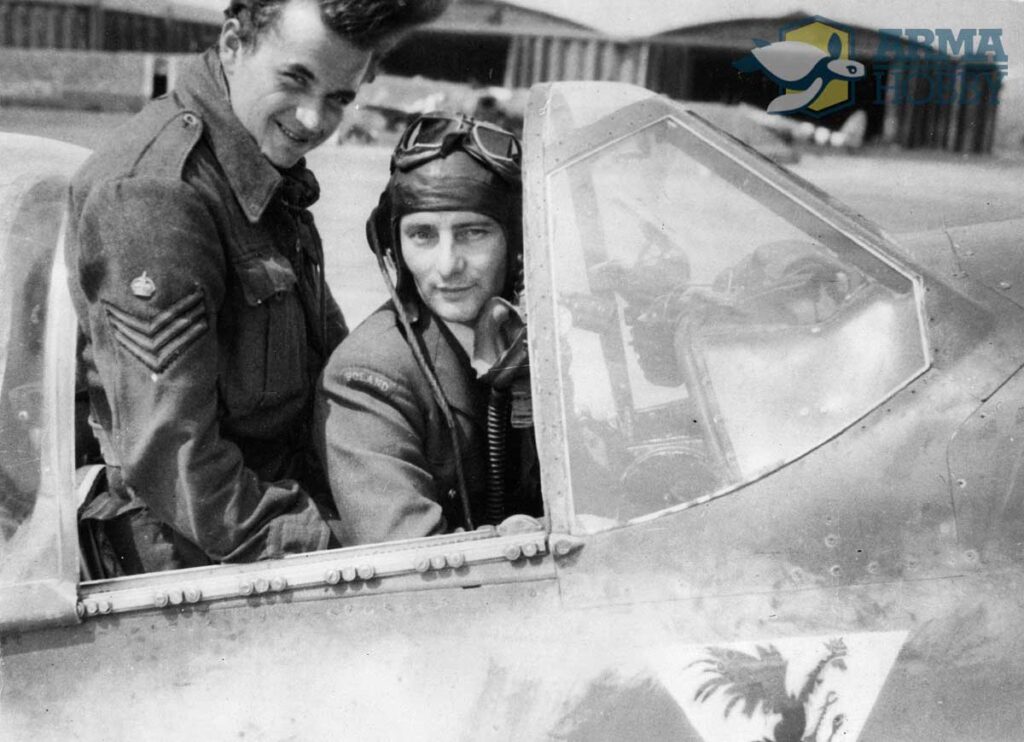
On 22 June 1944 he saved one of his pilots, W/O Tadeusz Tamowicz, who had force-landed in front-line area in France: he landed nearby, reached his man by jeep, brought him to his Mustang and delivered him back to base (sitting on his lap). In this photo, taken on 25 June at RAF Ford, Horbaczewski (with his headgear and goggles on) and F/Sgt Tadeusz Słoń demonstrate how two men can squeeze themselves together into a Mustang cockpit.
See also:
- P-51 B/C Mustang™ Mk III Model Kit and more in Arma Hobby shop link
Aircraft engineer by education, translator by trade. Author/co-author of over 50 books on the history of (mostly Polish) aviation, published in various countries and languages, including a biography of Tadeusz Sawicz, a number of biographical dictionaries, the fundamental Historia lotnictwa w Polsce (History of Aviation in Poland), and the first complete history of 303 Squadron.
This post is also available in:
 polski
polski


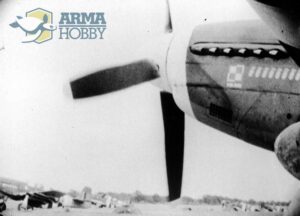















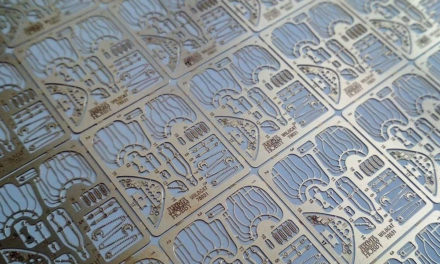

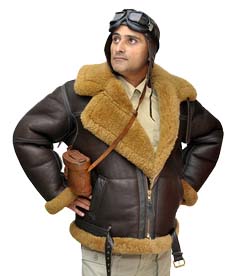
brilliant research, I’m about to make Horbie’s Mustang. Heroic chap, rest in peace my friend